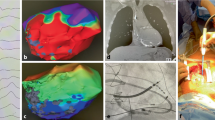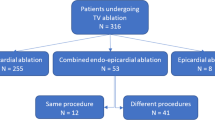Abstract
Background
Ventricular tachycardia clustering (VTc) is associated with a worse clinical outcome in patients with non-ischemic dilated cardiomyopathy (NI-DCM) and implantable cardioverter defibrillator (ICD); however, its role after catheter ablation (CA) has still not been investigated. Aim of this study was to evaluate the prognostic significance of VTc after CA.
Methods
96 consecutive patients (59 ± 13 years, 82% males) with NI-DCM underwent CA for drug-refractory VT. After CA, patients with VT recurrence were divided into two groups: (1) patients that presented with VTc defined as the occurrence of three or more appropriate ICD interventions within 2 weeks, and (2) patients without VTc.
Results
At 56-months follow-up after ablation 52/96 (54%) patients had recurrent VT, 28/52 (54%) patients experienced VTc and 24/52 (46%) no VTc. When comparing patients with VTc after CA with those without, no differences in terms of age, sex, ejection fraction and cardiovascular risk factors were found. However, patients with VTc showed higher mortality rates at follow-up (54% vs 21% p = 0.04; log-rank p ≤ 0.01). No survival differences were found between patients without VT recurrence and those with VT recurrence but without VTc (29% vs 21% p = 0.77). Predictors of VTc were LVEF < 30% at follow-up and endo–epicardial scar at 3D voltage mapping. At stepwise multivariate analysis VTc and NHYA class were the only independent predictors of death (respectively, RR 3.4, CI 95% 1.16–10.3, p = 0.02; RR 4.18, CI 95% 1.3–12.6, p = 0.01).
Conclusions
VTc after CA is an independent predictor of survival and is associated with reduced LVEF at follow-up and endo–epicardial scar at 3D voltage mapping.




Similar content being viewed by others
References
Muser D, Santangeli P, Castro SA, Pathak RK, Liang JJ, Hayashi T, Magnani S, Garcia FC, Hutchinson MD, Supple GG, Frankel DS, Riley MP, Lin D, Schaller RD, Dixit S, Zado ES, Callans DJ, Marchlinski FE. Long-term outcome after catheter ablation of ventricular tachycardia in patients with nonischemic dilated cardiomyopathy. Circ Arrhythm Electrophysiol. 2016;9(10)
Tung R, Vaseghi M, Frankel DS, Vergara P, Di Biase L, Nagashima K, Yu R, Vangala S, Tseng CH, Choi EK, Khurshid S, Patel M, Mathuria N, Nakahara S, Tzou WS, Sauer WH, Vakil K, Tedrow U, Burkhardt JD, Tholakanahalli VN, Saliaris A, Dickfeld T, Weiss JP, Bunch TJ, Reddy M, Kanmanthareddy A, Callans DJ, Lakkireddy D, Natale A, Marchlinski F, Stevenson WG, Della Bella P, Shivkumar K (2015) Freedom from recurrent ventricular tachycardia after catheter ablation is associated with improved survival in patients with structural heart disease: An International VT Ablation Center Collaborative Group study. Heart Rhythm 12(9):1997–2007
Bänsch D, Böcker D, Brunn J, Weber M, Breithardt G, Block M (2000) Clusters of ventricular tachycardias signify impaired survival in patients with idiopathic dilated cardiomyopathy and implantable cardioverter defibrillators. J Am Coll Cardiol 36(2):566–573
Schmidt B, Chun KR, Baensch D, Antz M, Koektuerk B, Tilz RR, Metzner A, Ouyang F, Kuck KH (2010 Dec) Catheter ablation for ventricular tachycardia after failed endocardial ablation: epicardial substrate or inappropriate endocardial ablation? Heart Rhythm 7(12):1746–1752
Yoshiga Y, Mathew S, Wissner E, Tilz R, Fuernkranz A, Metzner A, Rillig A, Konstantinidou M, Igarashi M, Kuck KH, Ouyang F (2012) Correlation between substrate location and ablation strategy in patients with ventricular tachycardia late after myocardial infarction. Heart Rhythm 9(8):1192–1199
Cano O, Hutchinson M, Lin D, Garcia F, Zado E, Bala R, Riley M, Cooper J, Dixit S, Gerstenfeld E, Callans D, Marchlinski FE (2009) Electroanatomic substrate and ablation outcome for suspected epicardial ventricular tachycardia in left ventricular nonischemic cardiomyopathy. J Am Coll Cardiol 54(9):799–808
Lunati M, Gasparini M, Bocchiardo M, Curnis A, Landolina M, Carboni A, Luzzi G, Zanotto G, Ravazzi P, Magenta G, Denaro A, Distefano P, Grammatico A, InSync ICD Italian Registry Investigators (2006) Clustering of ventricular tachyarrhythmias in heart failure patients implanted with a biventricular cardioverter defibrillator. J Cardiovasc Electrophysiol 17(12):1299–1306
Grom A, Baron TW, Faber TS, Brunner M, Bode C, Zehender M (2001) Clusters of life-threatening ventricular arrhythmias in patients with implanted cardioverter-defibrillators: prevalence, characteristics, and risk stratification. Clin Cardiol 24(4):330–333
Stuber T, Eigenmann C, Delacrétaz E (2005) Characteristics and relevance of clustering ventricular arrhythmias in defibrillator recipients. Pacing Clin Electrophysiol 28(7):702–707
Wood MA, Simpson PM, Stambler BS, Herre JM, Bernstein RC, Ellenbogen KA (1995) Long-term temporal patterns of ventricular tachyarrhythmias. Circulation 91(9):2371–2377
Englund A, Behrens S, Wegscheider K, Rowland E (1999) Circadian variation of malignant ventricular arrhythmias in patients with ischemic and nonischemic heart disease after cardioverter defibrillator implantation. European 7219 Jewel Investigators. J Am Coll Cardiol 34(5):1560–1568
Guerra F, Bonelli P, Flori M, Cipolletta L, Carbucicchio C, Izquierdo M, Kozluk E, Shivkumar K, Vaseghi M, Patani F, Cupido C, Pala S, Ruiz-Granell R, Ferrero A, Tondo C, Capucci A (2017) Temporal trends and temperature-related incidence of electrical storm: the TEMPEST study (temperature-related incidence of electrical storm). Circ Arrhythm Electrophysiol 10(3):pii: e004634
Liuba I, Frankel DS, Riley MP, Hutchinson MD, Lin D, Garcia FC, Callans DJ, Supple GE, Dixit S, Bala R, Squara F, Zado ES, Marchlinski FE (2014) Scar progression in patients with nonischemic cardiomyopathy and ventricular arrhythmias. Heart Rhythm 11(5):755–762
Piers SR, Everaerts K, van der Geest RJ, Hazebroek MR, Siebelink HM, Pison LA, Schalij MJ, Bekkers SC, Heymans S, Zeppenfeld K (2015) Myocardial scar predicts monomorphic ventricular tachycardia but not polymorphic ventricular tachycardia or ventricular fibrillation in nonischemic dilated cardiomyopathy. Heart Rhythm 12(10):2106–2114
Gulati A, Jabbour A, Ismail TF, Guha K, Khwaja J, Raza S, Morarji K, Brown TD, Ismail NA, Dweck MR, Di Pietro E, Roughton M, Wage R, Daryani Y, O’Hanlon R, Sheppard MN, Alpendurada F, Lyon AR, Cook SA, Cowie MR, Assomull RG, Pennell DJ, Prasad SK (2013) Association of fibrosis with mortality and sudden cardiac death in patients with nonischemic dilated cardiomyopathy. JAMA 309(9):896–908
Dinov B, Fiedler L, Schönbauer R, Bollmann A, Rolf S, Piorkowski C, Hindricks G, Arya A (2014) Outcomes in catheter ablation of ventricular tachycardia in dilated nonischemic cardiomyopathy compared with ischemic cardiomyopathy: results from the Prospective Heart Centre of Leipzig VT (HELP-VT) Study. Circulation 129:728–736
Gökoğlan Y, Mohanty S, Gianni C, Santangeli P, Trivedi C, Güneş MF, Bai R, Al-Ahmad A, Gallinghouse GJ, Horton R, Hranitzky PM, Sanchez JE, Beheiry S, Hongo R, Lakkireddy D, Reddy M, Schweikert RA, Dello Russo A, Casella M, Tondo C, Burkhardt JD, Themistoclakis S, Di Biase L, Natale A (2016) Scar homogenization versus limited-substrate ablation in patients with nonischemic cardiomyopathy and ventricular tachycardia. J Am Coll Cardiol 68(18):1990–1998
Villacastin J, Almendral J, Arenal A et al (1996) Incidence and clinical significance of multiple consecutive, appropriate, high-energy discharges in patients with implanted cardioverter-defibrillators. Circulation 93:753–763
Whang W, Mittleman MA, Rich DQ, Wang PJ, Ruskin JN, Tofler GH, Muller JE, Albert CM (2004) TOVA Investigators. Heart failure and the risk of shocks in patients with implantable cardioverter defibrillators: results from the Triggers Of Ventricular Arrhythmias (TOVA) study. Circulation 109(11):1386–1391
Kuck KH, Schaumann A, Eckardt L, Willems S, Ventura R, Delacrétaz E, Pitschner HF, Kautzner J, Schumacher B, Hansen PS; VTACH study group. Catheter ablation of stable ventricular tachycardia before defibrillator implantation in patients with coronary heart disease (VTACH): a multicentre randomised controlled trial. Lancet 375(9708):31–40
Reddy VY, Reynolds MR, Neuzil P, Richardson AW, Taborsky M, Jongnarangsin K, Kralovec S, Sediva L, Ruskin JN, Josephson ME (2007) Prophylactic catheter ablation for the prevention of defibrillator therapy. N Engl J Med 27(26):2657–2665(
Author information
Authors and Affiliations
Corresponding author
Rights and permissions
About this article
Cite this article
Santoro, F., Metzner, A., Scholz, L. et al. Prognostic significance of ventricular tachycardia clustering after catheter ablation in non-ischemic dilated cardiomyopathy. Clin Res Cardiol 108, 539–548 (2019). https://doi.org/10.1007/s00392-018-1384-2
Received:
Accepted:
Published:
Issue Date:
DOI: https://doi.org/10.1007/s00392-018-1384-2




